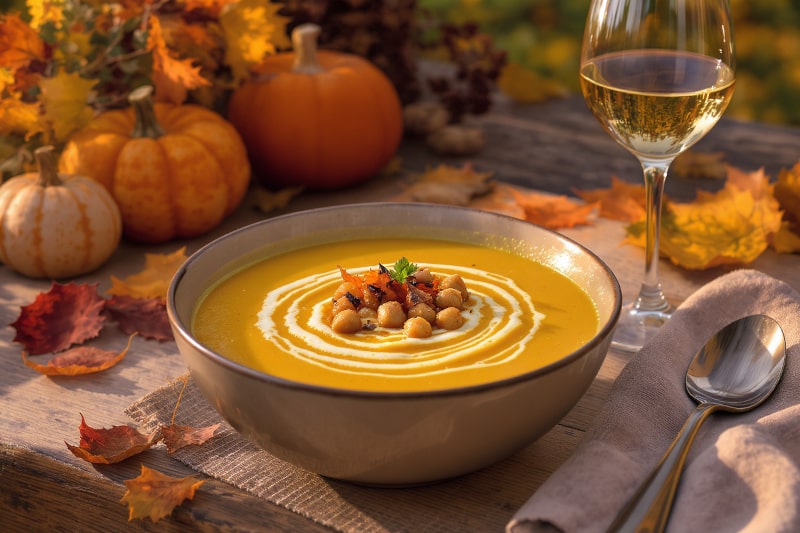Velvety, spicy, crispy – the feel-good soup for fall
Wine with food thrives on balance and finely tuned flavors – which is exactly what this soup delivers. Wine and food combine here to create a creamy, spicy experience with an elegant crunch. The parsnip and pumpkin soup combines the earthy sweetness of root vegetables with the warm spice of a mild curry; coconut milk provides silkiness, while roasted chickpeas add texture and nutty notes. Each spoonful brings depth and lightness to the palate: gentle sweetness, fine spice, round melting – and the crispy counterpoint on top. A wine with fragrant fruit, a creamy texture and clear, non-dominant acidity fits in perfectly here and enhances the aromas without drowning them out. This turns a simple autumn soup into a small, elegant pairing statement.
Ideal wine accompaniment: Viognier (Languedoc, France)
A Viognier from the Languedoc is the perfect partner because it reflects the key moments of this dish: Fragrance, smoothness and spice. Typical aromas include white peach, apricot, candied lemon and acacia blossom, often with a hint of nutmeg. This fruity-floral opulence picks up on the natural sweetness of the pumpkin and parsnip, while the creamy, almost oily texture of the Viognier is a congenial accompaniment to the velvety soup. Its moderately fresh acidity provides a clear counterpoint to the coconut milk and keeps the overall picture lively. At the same time, the subtle spice nuances pick up the curry thread without emphasizing the spiciness. The result: the soup appears more defined, more fragrant and longer, the wine rounder and even more aromatic – a harmonious liaison in which both sides win.
Further wine recommendations for this dish
Grüner Veltliner Smaragd (Wachau DAC, Austria)
Grüner Veltliner is the chameleon wine for vegetable and spice cuisine. The Smaragd version combines substance with peppery spice, ripe stone fruit and herbal notes. This spiciness harmonizes beautifully with the mild curry, while the pithy but never sharp acidity lifts the creaminess of the soup and refines the mouthfeel. The ripe fruit (pear, quince, yellow apple) docks onto the pumpkin and parsnip sweetness; a delicate, often nutty structure frames the roasted chickpeas. The result is a lively interplay of creaminess and freshness, spice and fruit. This is a perfect choice for anyone looking for a dry, structured white wine with a real food drive.
Riesling Spätlese QmP (Mosel, Germany)
A delicately fruity Spätlese delivers what creamy, spicy soups love: dancing acidity, delicate sweetness and crystalline length. Peach, apricot and citrus peel reflect the pumpkin fruit, while the delicate residual sweetness buffers the light curry spiciness and elegantly weaves in the coconut melt. The minerality typical of the Moselle stretches the palate and never makes the soup seem heavy despite its creaminess. The way the sweet and sour balance brightens up the roasted aromas of the chickpeas and gives them a shine is particularly beautiful. The pairing is playful yet precise – ideal when guests have different spiciness tolerances and you want to achieve maximum balance with one wine.
Chenin Blanc (Stellenbosch WO, South Africa)
Dry Chenin Blanc from South Africa combines citrus freshness, apple-quince aromas and fine honey notes with taut acidity and an often creamy mid-palate. This architecture goes perfectly with soup: the acidity enlivens the coconut creaminess, quince and honey embrace the pumpkin and parsnip, while a light, salty minerality structures the spice of the curry. Many South African Chenins also show subtle nuttiness that corresponds with the chickpea crunch. In the mouth, there is tension without austerity, depth without heaviness – a modern, enormously versatile culinary style that meets both everyday and fine dining requirements.
Torrontés (Salta, Argentina)
Torrontés is aromatic yet dry – with notes of lychee, peach and orange blossom that beautifully enhance the soup’s fragrance profile. The moderate acidity leaves room for texture, allowing the wine and coconut melt to intertwine seamlessly. At the same time, the exotic aroma captures the curry character without appearing “perfumed”. Particularly appealing: the combination of floral lightness and subtle spiciness, which creates a fragrant stage for the roasted chickpea notes. The result is a bright, fragrance-driven pairing that immediately elicits a “Wow, that fits!” from guests – ideal if you want to offer a surprising alternative away from the European classics.
Albariño (Rías Baixas DO, Spain)
Albariño brings a maritime freshness kick, citrus, white peach and a fine saltiness. It is precisely this combination that firms up the creamy soup and makes the vegetable sweetness appear more defined. The juicy but never sharp acidity helps to keep the curry and coconut in balance; the delicate bitter note in the finish (grapefruit zest) provides culinary contour. The wine thus emphasizes the brightness, freshness and animation of the dish without taking away the pleasant warmth. For lovers of straightforward, precise white wines, Albariño is a dream – and as a contrast to the more opulent Viognier, a deliberately “taut” alternative with great pairing potential.
The recipe:

Pastinaken-Kürbis-Suppe mit Curry & gerösteten Kichererbsen
Cooking utensils
- 1 Topf
- 1 Pfanne
- 1 Mixer oder Stabmixer
- 1 Schüssel
- 1 Kochlöffel
- 1 Sieb
Ingredients
Suppe
- 200 g Pastinaken gewürfelt
- 200 g Hokkaido-Kürbis ohne Kerne, gewürfelt
- 1 Zwiebel fein gehackt
- 1 Knoblauchzehe fein gehackt
- 500 ml Gemüsebrühe
- 100 ml Kokosmilch
- 1 TL mildes Currypulver
- 1 EL Olivenöl
- Salz & Pfeffer
Geröstete Kichererbsen
- 120 g Kichererbsen gekocht/abgespült
- 1 EL Olivenöl
- ½ TL Paprikapulver edelsüß
- Salz
Preparation
Vorbereitung
- Pastinaken und Kürbis schälen (Hokkaido nur entkernen) und würfeln.
- Zwiebel und Knoblauch fein hacken.
- Kichererbsen abspülen und sehr gut abtropfen lassen.
Suppe kochen
- Olivenöl im Topf erhitzen, Zwiebel und Knoblauch glasig anschwitzen.
- Pastinake und Kürbis zugeben, 2–3 Minuten anschwitzen.
- Mit Gemüsebrühe aufgießen und 15 Minuten weich köcheln.
- Kokosmilch und Curry einrühren, glatt pürieren, mit Salz & Pfeffer abschmecken.
Geröstete Kichererbsen
- Pfanne erhitzen, Kichererbsen mit Öl und Paprika 5–7 Minuten rösten, bis sie knusprig sind.
- Salzen und beiseitestellen.
Servieren
- Suppe in vorgewärmte Schalen füllen.
- Kichererbsen darüber streuen, optional mit Kräutern oder einem Klecks Joghurt garnieren.
Empfohlene Beilagen:
- Rustikales Bauernbrot
- Knuspriges Ciabatta
- Kräuter-Croutons
